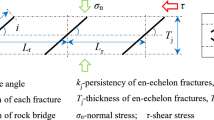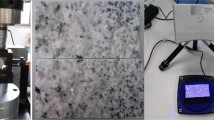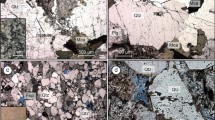Abstract
Understanding and predicting the shear mechanical characteristics of rock fractures subjected to different pore water pressures is vital for the safety and the stability of the reservoir bank slope. A series of direct shear tests were conducted on granite fractures covering various reservoir impoundment-relevant pore water pressures. The results reveal that as pore water pressure increases, the peak shear strength, residual shear strength, shear stiffness, and peak shear displacement show a decreased trend, while the peak dilation increases with the pore water pressure. The shear-induced reductions in fracture surface parameter (Z2) and the sheared-off volumes of asperities decrease with the increase in pore water pressure. An empirical function is presented to successfully describe the evolutions of the shear parameters and the volume of sheared-off asperities with pore water pressure. Under drained conditions, it is found that shear failure will cause a transient drop in pore water pressure, and the pore water pressure fluctuation coefficient can be used as an early warning indicator for potential damage of fractures. In addition, a singular-value decomposition method is employed to fit the peak and residual shear strength with pore water pressure, which indicates that the effective stress principle can satisfactorily explain the hydro-mechanical mechanism of rock fractures. Before the shear failure, the effective stress coefficient is close to unit, while it is reduced after the shear failure due to the increase in the actual contact area caused by asperity degradation and gouge formation.
Highlights
-
An empirical formula is proposed to quantify the shear mechanical parameters of rock fractures under different pore water pressure.
-
Effective stress coefficient tends to decrease after shear failure due to the increased actual contact area caused by asperity degradation and gouge formation.
-
The pore water pressure fluctuation coefficient is presented as an early warning indicator for potential damage of fractures.
-
The effective stress principle can satisfactorily explain the hydro-mechanical mechanism of rock fractures.









Similar content being viewed by others
Data availability
All data analyzed during this work are included in this published paper and are available from the corresponding author on reasonable request.
References
Asahina D, Pan PZ, Sato M, Takeda M, Takahashi M (2019) Hydraulic and mechanical responses of porous sandstone during pore pressure-induced reactivation of fracture planes: an experimental study. Rock Mech Rock Eng 52:1645–1656
Barton N, Choubey V (1977) The shear strength of rock joints in theory and practice. Rock Mech 10(1):1–54
Bernabe Y (1987) The effective pressure law for permeability during pore pressure and confining pressure cycling of several crystalline rocks. J Geophys Res-Solid Earth 92(B1):649–657
Bidgoli MN, **g L (2015) Water pressure effects on strength and deformability of fractured rocks under low confining pressures. Rock Mech Rock Eng 48:971–985
Biot MA, Willis DG (1957) The elastic coefficients of the theory of consolidation. J Appl Mech 24(2):594–601
Boitnott GN, Scholz CH (1990) Direct measurement of the effective pressure law: Deformation of joints subject to pore and confining pressures. J Geophys Res-Solid Earth 95(B12):19279–19298
Brodsky EE, Kanamori H (2001) Elastohydrodynamic lubrication of faults. J Geophys Res-Solid Earth 106:16357–16374
Chen YD, Liang WG, Selvadurai APS, Zhao ZH (2021) Influence of asperity degradation and gouge formation on flow during rock fracture shearing. Int J Rock Mech Min Sci 143:104795
Diao YJ, Espinosa-Marzal RM (2018) The role of water in fault lubrication. Nat Commun 9:2309
Dou ZH, Gao TY, Zhao ZH, Li JJ, Yang Q, Shang DL (2020) The role of water lubrication in critical state fault slip. Eng Geol 271:105606
Dou ZH, Gao TY, Zhao ZH, Li JJ, Yang Q, Yi S (2021) Effect of immersion duration on shear behavior of granite fractures. Rock Mech Rock Eng 54:4809–4823
Ellsworth WL (2013) Injection-induced earthquakes. Science 341:6142
Gu DM, Huang D, Yang WD, Zhu JL, Fu GY (2017) Understanding the triggering mechanism and possible kinematic evolution of a reactivated landslide in the three Gorges reservoir. Landslides 14:2073–2087
Gutierrez M, Øino LE, Nygård R (2000) Stress-dependent permeability of a de-mineralised fracture in shale. Mar Pet Geol 17:895–907
Hampton JC, Boitnott GN (2018) The misnomer of "Effective Stress" and its relation to Biot Coefficients. In: Proceedings of the 52nd U.S. Rock Mechanics/Geomechanics Symposium, Seattle, Washington, 1130
Harp EL, Wells WG, Sarmiento JG (1990) Pore pressure response during failure in soils. Geol Soc Am Bull 102(4):428–438
Hencher SR, Richards LR (2015) Assessing the shear strength of rock discontinuities at laboratory and field scales. Rock Mech Rock Eng 48:883–905
Hu DW, Zhou H, **e SY, Zhang K, Shao JF, Feng XT (2009) Study of Biot’s coefficients of marble during plastic deformation phase. Rock Soil Mech 30(12):3727–3734
Hubbert MK, Rubey WW (1959) Role of fluid pressure in mechanics of overthrust faulting: I. Mechanics of fluid-filled porous solids and its application to overthrust faulting. Geol Soc Am Bull 70(2):115–166
Ikari MJ, Kopf AJ (2011) Cohesive strength of clay-rich sediment. Geophys Res Lett 38(16):L16309
Jaeger JC, Cook NGW, Zimmerman RW (2009) Fundamentals of rock mechanics. John Wiley & Sons
Ji YL, Hofmann H, Duan K, Zang A (2022) Laboratory experiments on fault behavior towards better understanding of injection-induced seismicity in geoenergy systems. Earth-Sci Rev 226:103916
**g L, Stephansson O (2007) Fundamentals of discrete element methods for rock engineering: theory and application, vol 85, 1st edn. Elsevier, Amsterdam
Kim T, Jeon S (2019) Experimental study on shear behavior of a rock discontinuity under various thermal, hydraulic and mechanical conditions. Rock Mech Rock Eng 52:2207–2226
Li Y, Zhang Y (2015) Quantitative estimation of joint roughness coefficient using statistical parameters. Int J Rock Mech Min Sci 77:27–35
Li B, Ye XN, Dou ZH, Zhao ZH, Li YC, Yang Q (2020) Shear strength of rock fractures under dry, surface wet and saturated conditions. Rock Mech Rock Eng 53:2605–2622
Lin D, Xu WY, Wang HL, Ji H (2019) Experimental study on strength characteristics of columnar jointed rock mass under the seepage. J Hohai Univers 47(2):151–155
Liu YR, Wang XM, Wu ZS, He Z, Yang Q (2018) Simulation of landslide-induced surges and analysis of impact on dam based on stability evaluation of reservoir bank slope. Landslides 15(10):2031–2045
Maihemuti B, Wang EZ, Hudan T, Xu QJ (2016) Numerical simulation analysis of reservoir bank fractured rock-slope deformation and failure processes. Int J Geomech 16(2):04015058
Muralha J, Grasselli G, Tatone B, Blümel M, Chryssanthakis P, Jiang Y (2014) ISRM suggested method for laboratory determination of the shear strength of rock joints: revised version. Rock Mech Rock Eng 47:291–302
Nishiyama S, Ohnishi Y, Ito H, Yano T (2014) Mechanical and hydraulic behavior of a rock fracture under shear deformation. Earth Planet Sp 66:108
Nouailletas O, Perlot C, Rivard P, Ballivy G, La Borderie C (2017) Impact of acid attack on the shear behaviour of a carbonate rock joint. Rock Mech Rock Eng 50:1439–1451
Paronuzzi P, Rigo E, Bolla A (2013) Influence of filling-drawdown cycles of the Vajont reservoir on 787 Mt. Toc Slope Stability Geomorphol 191:75–93
Passelègue FX, Brantut N, Mitchell TM (2018) Fault reactivation by fluid injection: controls from stress state and injection rate. Geophys Res Lett 45(23):12837–12846
Perera MSA, Rathnaweera TD, Ranjith PG, Wanniarachchi WAM, Nasvi MCA, Abdulagatov IM, Haque A (2016) Laboratory measurement of deformation-induced hydro-mechanical properties of reservoir rock in deep saline aquifers: an experimental study of Hawkesbury formation. Mar Pet Geol 77:640–652
Pluymakers AM, Samuelson JE, Niemeijer AR, Spiers CJ (2014) Effects of temperature and CO2 on the frictional behavior of simulated anhydrite fault rock. J Geophys Res-Solid Earth 119:8728–8747
Raviv U, Klein J (2002) Fluidity of Bound Hydration Layers. Science 297(5586):1540–1543
Rempe M, Di Toro G, Mitchell TM, Smith SAF, Hirose T, Renner J (2020) Influence of effective stress and pore fluid pressure on fault strength and slip localization in carbonate slip zones. J Geophys Res-Solid Earth 125(11):e2020JB019805
Rutter E, Hackston A (2017) On the effective stress law for rock-on-rock frictional sliding, and fault slip triggered by means of fluid injection. Philos Trans A Math Phys Eng Sci 375(2103):20160001
Scholz CH (2002) The mechanics of earthquakes and faulting. Cambridge University, Cambridge
Shang DL, Zhao ZH, Dou ZH, Yang Q (2020) Shear behaviors of granite fractures immersed in chemical solutions. Eng Geol 279:105869
Silva MR, Schroeder C, Verbrugge JC (2010) Poroelastic behaviour of a water-saturated limestone. Int J Rock Mech Min Sci 47:797–807
Sotin C, Poirier JP (1984) Analysis of high-temperature creep experiments by generalized nonlinear inversion. Mech Mater 3(4):311–317
Tan X, Konietzky H (2017) Numerical study of biot’s coefficient evolution during failure process for aue granite using an empirical equation based on GMR method. Rock Mech Rock Eng 50:1683–1689
Tan X, Konietzky H, Frühwirt T (2015) Experimental and numerical study on evolution of Biot’s coefficient during failure process for brittle rocks. Rock Mech Rock Eng 48:1289–1296
Tien YM, Lee DH, Juang CH (1990) Strain, pore pressure and fatigue characteristics of sandstone under various load conditions. Int J Rock Mech Min Sci & Geomech Abstr 27(4):283–289
Tsao TM, Wang MK, Chen MC, Takeuchi Y, Matsuura S, Ochiai H (2005) A case study of the pore water pressure fluctuation on the slip surface using horizontal borehole works on drainage well. Eng Geol 78(1–2):105–118
Tse R, Cruden DM (1979) Estimating joint roughness coefficients. Int J Rock Mech Min Sci Geomech Abstr 16(5):303–307
Tuncay K, Corapcioglu MY (1995) Effective stress principle for saturated fractured porous media. Water Resour Res 31(12):3103–3106
Verberne BA, Spiers CJ, Niemeijer AR, De Bresser JHP, De Winter DAM, Plümper O (2014) Frictional properties and microstructure of calcite-rich fault gouges sheared at sub-seismic sliding velocities. Pure Appl Geophys 171:2617–2640
Wang Y, Jeannin L, Agostini F, Dormieux L, Skoczylas F, Portier E (2018) Experimental study and micromechanical interpretation of the poroelastic behaviour and permeability of a tight sandstone. Int J Rock Mech Min Sci 103:89–95
Wei Wu, Reece JS, Gensterblum Y, Zoback MD (2017) Permeability evolution of slowly slip** faults in shale reservoirs. Geophys Res Lett 44:11368–11375
Wu AQ, Fan L, Fu X, Zhang YH, Zhong ZW, Yu MW (2021) Design and application of hydro-mechanical coupling test system for simulating rock masses in high dam reservoir operations. Int J Rock Mech Min Sci 140:104638
**a M, Ren GM, Li TB, Cai M, Yang TJ, Wan ZL (2019) Complex rock slope deformation at Laxiwa hydropower station, China: background, characterization, and mechanism. Bull Eng Geol Environ 78(5):3323–3336
Xu LH, **e N (2009) Test and theoretical research on permeability characteristics of shear fracture in rock mass. Chin J Rock Mech Eng 28(11):2249–2257
Yang Z, Lo S, Di C (2001) Reassessing the joint roughness coefficient (JRC) estimation using Z2. Rock Mech Rock Eng 34:243–251
Yang SQ, **g HW, Cheng L (2014) Influences of pore pressure on short-term and creep mechanical behaviour of red sandstone. Eng Geol 179:10–23
Zhang DX, Wang GH, Yang TJ, Zhang MC, Chen SH, Zhang FY (2013) Satellite remote 824 sensing-based detection of the deformation of a reservoir bank slope in Laxiwa Hydropower Station, 825 China. Landslides 10(2):231–238
Zhang Q, Li XC, Bai B, Hu SB, Shi L (2018) Effect of pore fluid pressure on the normal deformation of a matched granite joint. Processes 6(8):107
Zhang Q, Li XC, Bai B, Hu HX (2019) The shear behavior of sandstone joints under different fluid and temperature conditions. Eng Geol 257:105143
Zhang ZJ, Zhang QY, Duan K, Ren MY, Yin XJ, Lin HX, **ang W (2021) Experimental study on the mechanical and permeability behaviors of limestone under hydro-mechanical-coupled conditions. Bull Eng Geol Environ 80:2859–2873
Zhao ZH, Yang J, Zhou D, Chen YF (2017) Experimental investigation on the wetting-induced weakening of sandstone joints. Eng Geol 225:61–67
Zhao ZH, Guo TC, Ning ZY, Dou ZH, Dai F, Yang Q (2018a) Numerical modeling of stability of fractured reservoir bank slopes subjected to water-rock interactions. Rock Mech Rock Eng 51:2517–2531
Zhao ZH, Peng H, Wu W, Chen YF (2018b) Characteristics of shear-induced asperity degradation of rock fractures and implications for solute retardation. Int J Rock Mech Min Sci 105:53–61
Zoback MD (2010) Reservoir Geomechanics. Cambridge University Press, Cambridge, United Kingdom
Acknowledgements
This work was supported by the National Natural Science Foundation of China (Grant No. 41961134032) and the Swiss National Science Foundation (Grant No. 189882).
Author information
Authors and Affiliations
Corresponding author
Additional information
Publisher's Note
Springer Nature remains neutral with regard to jurisdictional claims in published maps and institutional affiliations.
Appendix
Rights and permissions
Springer Nature or its licensor (e.g. a society or other partner) holds exclusive rights to this article under a publishing agreement with the author(s) or other rightsholder(s); author self-archiving of the accepted manuscript version of this article is solely governed by the terms of such publishing agreement and applicable law.
About this article
Cite this article
Zhang, K., Lyu, Q., Liu, Y. et al. Shear Behavior and Properties of Granite Fractures Under Different Pore Water Pressure Conditions. Rock Mech Rock Eng 56, 6045–6060 (2023). https://doi.org/10.1007/s00603-023-03386-0
Received:
Accepted:
Published:
Issue Date:
DOI: https://doi.org/10.1007/s00603-023-03386-0




